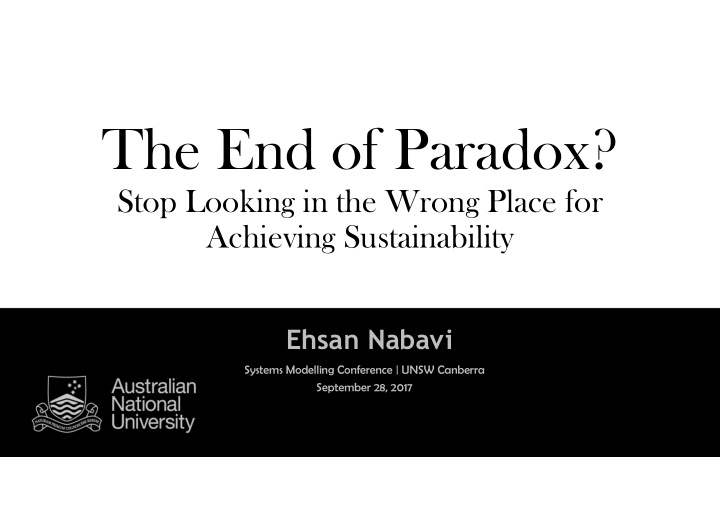



The End of Paradox? Stop Looking in the Wrong Place for Achieving Sustainability Ehsan Nabavi Systems Modelling Conference | UNSW Canberra September 28, 2017
What are the most efficient cars to drive today? Why Is Fuel Economy So Important? When comparing cars with different fuel economies, it’s important understand that the car with the better fuel economy will use less fuel to cover the same distance which will therefore have a lower impact on your wallet and the environment . This is why cars with good fuel economy are often referred to as ‘green’ vehicles or environmentally friendly models. Not only will you be saving money at the petrol pump each week, you’ll also be reducing your greenhouse gas emissions and carbon footprint. www.comparethemarket.com.au
What are the most efficient cars to drive today? The Australian government's Green Vehicle Guide provides some answers: 1.BMW i3 - annual fuel costs of $ 541 . 2.Mitsubishi iMiEV – ($ 567 per year). 3.Renault Kangoo ZE ($ 651 per year).
increasing energy efficiency = increasing productivity of energy reducing its implicit price, because you get more return for the same money
increasing energy efficiency = increasing productivity of energy reducing its implicit price, because you get more return for the same money increasing demand
i. Increased efficiency makes the use of energy relatively cheaper, thus encouraging increased use. ii. Increased efficiency leads to increased economic growth, which pulls up energy use in the whole economy. iii. Increased efficiency in any one bottleneck resource multiplies the use of all the companion technologies, products and services that were being restrained by it.
The Coal Question (William Jevons,1856) Increased efficiency of the Watt steam engine coal-fired steam engine coal became a more cost-effective power source increased use of the steam engine in a wide range of industries increased total coal consumption, even as the amount of coal required for any particular application fell
The Coal Question (William Jevons,1856) “ It is a confusion of ideas to suppose that the economical use of fuel is equivalent to diminished consumption. The very contrary is the truth .” The Jevons paradox: the economical use of fuel results not in diminished consumption but in an over-all increase
1993-2005 Improved energy efficiency of residential air- conditioning equipment 28% Energy consumption for A.C. by the average air-conditioned household rose 37%
Modern Analysis of Jevons Paradox Rebound Backfire Khazzoom–Brookes Downs–Thomson Paradox Pigou–Knight–Downs Lewis–Mogridge
Efficient Irrigation Technology Does it lead to reduced groundwater extraction?
widespread conversion from traditional center pivot irrigation systems to higher efficiency dropped-nozzle center pivot systems
Western Kansas, US Pfeiffer (2013) + + State and national cost- Irrigation efficiency Higher revenue share programs Shift to water improvements / lower costs subsidies for higher intensive crop mix irrigation efficiency More frequent & extensive use of irrigation
savings of increased resource efficiency can be viewed as New Resource
ZayandehRood, IRAN (Nabavi, 2011)
Real Water Deficit Demand Management Water Transfer Projects
Side Effect + R1 + + - Syptomic Fundamental Problem B2 B1 Solution Symptom Solution + -
Generates symptoms that demand attention Difficult for people to address It is obscure or costly to confront Solutions: well-intentioned, fixes which seem extremely efficient They leave the underlying problem unaltered It is unsustainable: The underlying problem grows worse
ZayandehRood, IRAN
Resource Stress Index ����� ������ ��� ���� Transfer + � � �� & � �� ����� ـ ����� ����� ـ ����� ����� ��������� ������� � Improving Efficiency Overexploited BAU
Annual real GDP produced in sector i (Rials); EPPP = Annual job opportunities which is generated in sector i (Person) X Annual water utilization in sector i (MCM) Transfer + Improving Efficiency BAU
Paradox Of The Paradox We simultaneously are aware of it and increasingly addict to it
Paradox Of The Paradox Appealing Features Improving efficiency is easy to endorse The efficiency discussions at the policy tables are never contentious No one is debating about who’s responsible, and there is no finger-pointing or playing the blame game Advocating efficiency involves virtually no political risk
P oliticizin g The Paradox political ecology of efficiency
From P aradox to P rinciple
The End of Paradox? Stop Looking in the Wrong Place for Achieving Sustainability Ehsan Nabavi Systems Modelling Conference | UNSW Canberra September 28, 2017
Recommend
More recommend